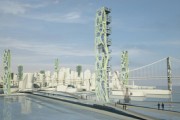
Anne Fougeron’s City of the Future Starts Now…
by Rebecca Firestone with Mark English AIA | Interviews
With 80% of the world’s arable land already in use, we are running out of land to feed ourselves. Land and water are fixed, finite resources; their scarcity could become a greater crisis than global warming, terrorism, or species extinction. One way to address that is by expanding the notion of what “land” is to include urban settings, to make regions like the Bay Area self-sustaining. Architect Anne Fougeron answers a few questions about her vision for a San Francisco 100 years in the future by saying, “People shouldn’t be allowed to come into this world only to starve.”
Let’s envision a possible future in 2085. The world’s population has leveled off at 14 billion souls and the only reason it’s not increasing is that over half of these people are literally remaindered – cut off from food production, contained in restricted areas and left to slowly starve to death while the rest of the world competes for the remaining scraps of arable land that haven’t been paved over with concrete. Occasional labor recruitment brigades will raid these “holding pens” for cheap forced labor that is willing to work in exchange for a few weeks’ worth of food. In a few privileged areas, even the dogs eat steak, but most people live on flavored vegetable protein – if they’re lucky enough to afford it. Even more than land, fresh water is a scarce and jealously guarded resource, serving as the de facto currency in the ever-increasing arid zones.
Sound impossible? We hope it is, but the point is that we can’t keep growing our food the way we have for the past 5,000 years. And we can’t keep transporting food halfway across the world, either. Even though it’s affordable today, needless transport wastes fuel and resources, pollutes the environment, and could leave us vulnerable to global infrastructure failures. Bay Area architect Anne Fougeron, FAIA, put it to me this way, saying, “We have a responsibility to feed people. People shouldn’t be allowed to come into this world only to starve.”
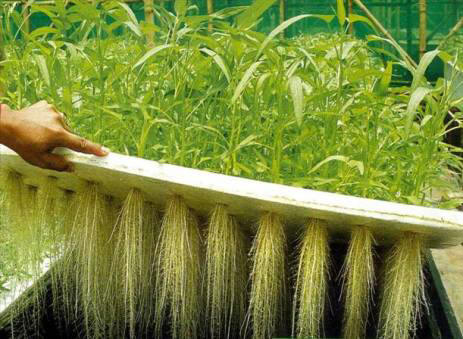
A lot of people are already hard at work developing high-tech aeroponic farming techniques, originally developed for NASA space shuttles.
The starting point for this discussion was that Fougeron had come up with a unique proposal for San Francisco’s City of the Future competition. Instead of focusing on a Dubai-like fantasy futurism with airy white spider-domes floating over impossibly green downtown areas, Fougeron focused on meeting an immediate practical need: a network of vertical farming towers that would feed the entire Bay Area by the year 2100. Here’s a summary of her slide show on the topic.
Not that Anne’s pictures weren’t pretty; there were airy renderings of soaring towers that suggested to me a new style of urban farming condominium. I thought of all the wealthy condo buyers out there and wondered how many of them had actually tilled the soil. I thought of the early Israeli “halutzim” (pioneers) who drained the malarial swamps of Palestine to create kibbutz-style collectives that today are seeking to transform themselves into more modern working communities. Our own national mythos is that of the self-reliant American pioneer, frontiersman, and farmer: an ideal that few of us embody today.
The Little Red Hen in me started to wonder about who would do the work in these new vertical farming towers and, more importantly, who would pay to build them. And, would these be some kind of “green living” collective social experiment, or would they all be taken over by multinational, profit-seeking conglomerates using low-wage, non-unionized labor? And – I’ll admit it, the first thing that comes to mind for Bay Area indoor farming isn’t tomatoes.
So I asked Anne Fougeron what she envisioned, and what it would take to start up even one in the Bay Area, just to see how it could work. Her concept included retrofitting and re-purposing of old buildings, similar to what is already happening in Europe and Japan.
Who would do the work to actually run the urban farms? When I first saw the pictures, for some reason it seemed that each urban dweller would be expected to grow their own food in their specially equipped ” Jetsons”-style apartments.
If you believe in capitalism, then you can either take care of your own land or pay others to do it. Some towers would be all agricultural, some would be mixed use and include commercial and residential uses.
The caveat here is that the City of the Future competition was to envision San Francisco 100 years from now. It was to pose a problem, not solve it all today. The point is, we can’t keep using the old farming methods because we’re running out of land, and we’re wasting resources by transporting the food over long distances. So let’s get started. By doing it, we figure out how it works. It’s not exactly clear what the outcome will be but we have to think positive.
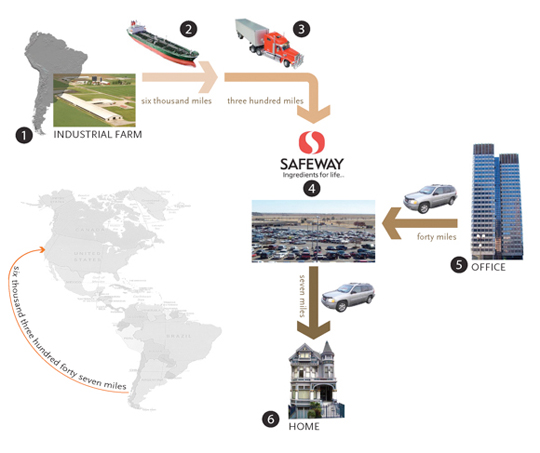
From Anne Fougeron’s slide show on vertical farming in the Bay Area, this shows how today’s food can travel over 6,000 miles to reach us.
The critics of vertical farming are focusing too narrowly on today’s technology and today’s ideas. The point is, we have to START investigating other technologies, and we have to start doing it soon. Twenty years ago, green technologies were laughed at. Everyone was still pretending that everything was fine, and even two years ago nobody accepted that global warming was a reality. Now the polar ice caps are melting and it’s a lot harder to deny that climate change is here, whether it’s man-made or not.
The main problem is that 80% of the arable land in the world is already occupied. By 2040, 80% of the world’s population will live in urban centers, pushing food production farther away.
Would the towers have livestock? I’m seeing cows on the 52nd story now… smelling them, too.
Pigs and chickens, yes. Cows need too much grazing land.
I think we’ll need livestock for protein – we can’t expect everyone to live on bean sprouts. However, hog farms are a huge source of pollution, and activists already protest the factory farming of chickens as inhumane.
A Dutch firm, MVRDV has already done a study on this called “Pig City“. To quote Archined Online’s description, since MVRDV’s project page is all in Dutch, “[the] Pig City project, financed in part by the Dutch Ministry of Agriculture, Nature and Fisheries. Pig City comprised 76 towers, each 622 metres high and with floors measuring 87 by 87 metres on which pigs are to be kept. These ‘pig flats’ were proposed as a possible means of optimising the production process in the intensive pig sector. Animal welfare and economic land use were important factors in developing the concept. Though the Pig City project was just a concept, MVRDV stressed that it was feasible and that they would readily implement it.”
(Editor note: the Archined summary of their own readers’ responses focused heavily on animal welfare – but guys, under what conditions are today’s pigs being raised? Are you all vegetarians? The pollution and smell would be a greater concern to me, and perhaps MVRDV has thought of some solutions for that other than washing the pig waste into the groundwater – which is what happens now. Back to Anne…)
If you look at food prices over the past century, they were remarkably stable until the 1960s. A lot of this was due to subsidies. What’s happening now with rising food prices is that the middle class is being priced out of the foods they want to eat. And this includes more meat. We can’t force everyone to eat a vegetarian diet, even though it theoretically takes fewer acres per person.
But let’s say that it takes three acres per person to feed a meat eating population. In 100 years, the projected population for the California Bay Area alone is 17 million. It’ll take half of California to feed the Bay Area alone, even assuming that California land is all arable – which it isn’t.
And some developing countries don’t have any arable land, because they have no water!
If we rely on venture capital like we do now, investors might prefer to focus on cash crops like marijuana, rather than actual foodstuffs. And everyone will still be removed from their own food production.
Being removed from your food production is not the main problem, it is where and how your food is produced that is the more serious issue. Too little land left, too many miles travelled by food products, too much water wasted. We have to be more green. Nature is way more complicated than we thought. When we meddle with these natural cycles, we don’t understand what we are doing and we can’t anticipate the consequences.

The “Plantagon” is an urban greenhouse designed by a Swedish firm of the same name, specifically intended for food cultivation.
What do you think of this quote “Britain’s MI5 security agency operates on the famous maxim that any society is only four missed meals away from complete anarchy.”
Yup, that pretty much covers it. That’s why our food supply is a matter of national security.
Who would fund all the towers and retrofits? It would be nice to interest some local green funding and put up a prototype here in town. But many green activists are anti-capitalist, and may say that agriculture today is dominated by a few players who seem more interested in saturating food markets with empty carbs, junk food, and sterile, genetically modified seed strains than in the health of people or our global ecosystems. Why would that be any different in the future vision?
Agriculture is big business, both private and public moneys. As you know, many crops are heavily subsidized by the USA government. This isn’t just a plot to corner the market in corn syrup and make us all fat, nor is it purely to support farm lobbyists in Washington. The government wants to make sure that farmland stays in production, doesn’t get swallowed up by urban development, so that we as a nation can continue to feed ourselves.
What I’m hearing you say is that vertical farms are not specifically about saving the planet or being green. They’re about feeding the world, by any means necessary. Let’s go back to places that are already doing it successfully.
Japan’s been successful, mainly in underground garages. Japan’s Ministry of Agriculture became concerned that Japan grows only 40% of the food it consumes. Pasona O2 was started as an agricultural training class for Japanese youth, and features computer-controlled plant factories as described in English here. (Pasona O2’s site is in Japanese.)

Rice fields at Pasona O2, an indoor farming facility in Japan. Photo by Everett Kennedy Brown/epa/Corbis
Green Fortune is some kind of consortium doing “Plantwalls” in various countries throughout Europe. The Plantwalls are not necessarily food-producing, but they do introduce more greenery into urban settings, encouraging urban horticulture and most likely improving indoor air quality. They also have something called “Streamgarden” which is described as a personal hydroponic garden for home or office, for growing herbs and spices. Green Fortune shows greenhouses on top of high-rises, which would be good for Northern Europe, where the outdoor growing season may otherwise be short.
What do you think the reaction from Planning would be if we proposed a prototype in an abandoned building right here in San Francisco? What about Oakland?
I think they’d be very interested. I presented some of these ideas to the San Francisco planners during the original City of the Future competition and they were fairly receptive.
How much would it cost?
We could start by reusing a single building down at the Shipyard or over around Hunters Point. It doesn’t have to be a multilevel operation to begin with. There are enormous hangars out there, or at Moffett Field, that are going unused.

Video still from Green Fortune Urban Cultivation showing a vision of rooftop greenhouses for Stockholm, Sweden. There one finds the notion of commercial greenhouses that rent space to private individuals for cultivation.
Yes, electricity is expensive. It’s hard to balance what offsets what, and how much of that electricity can be self-generated, or how much additional light would be needed. But we have to think of systemic gains as well, rather than focusing on single-facility return on investment. For example, building a farm in an re-purposed parking garage downtown could re-use the graywater from all the surrounding buildings. That water runs into the sewage system now, going to waste. Water is as important a resource as land, and is just as finite. There’s also the savings from reduced transport to consider. What does 1700 miles of shipping do to the environment in terms of fossil fuel consumption and pollution? I mean, I can buy lettuce in the store for $2 but what does that lettuce REALLY cost when you factor in transport?
The United States already has enormous agricultural subsidies, over $20B a year. These were introduced by President Franklin D. Roosevelt, after the Great Depression. Those subsidies aren’t just for agribusiness, they’re for national security, so that our country would retain the ability to feed ourselves in the event of a global war or disaster. Why couldn’t some of that funding go towards the development of vertical urban farming?
4 Responses to “Anne Fougeron’s City of the Future Starts Now…”
Leave a Reply
You must be logged in to post a comment.

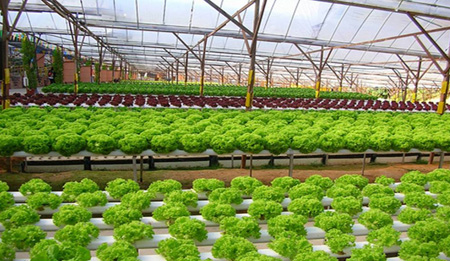
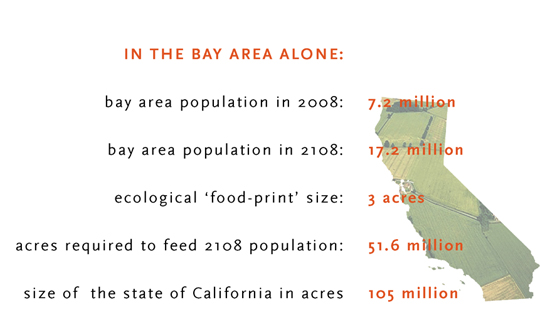





jill Pilaroscia
25. Nov, 2010
very interesting and well done article…especially liked the photographic examples of indoor farming, aeroponic farming and the plantagon –
eyeopening and important to think about food which I for one take for granted
blog wunderlust : 06 December 2010 | Architectural Design Concept
06. Dec, 2010
[…] leading architects | 360o view of London | concrete rings | Tall Buildings, Short Architects | City of the Future | Driver and Architect: The Hurdles of Rebuilding Haiti | Aga Khan 2010 […]
Eugene
06. Jan, 2011
Fascinating. Fantastic idea.
J.R.
09. Jan, 2012
I have always thought of skyscraper farming as a “think of first” profitable enterprise. It would be a great idea to socialize or create a “no profit motive law” to regulate the land purchases and corporate oligarchy on natural or humanly made natural resources.
Imagine a farm on the top stories, apartments for the employees and agricultural scientist and downstairs restaurant workers below. Highly attractive restaurant with all organic “local produce” ran by residences and owners.